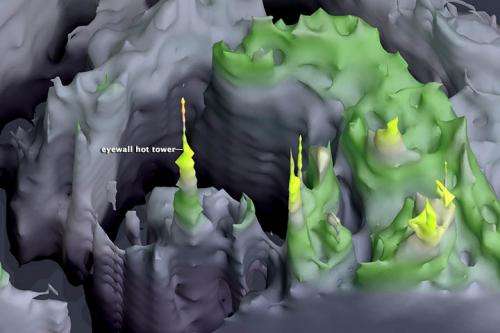Discovering 'hot towers'

Two hours before Hurricane Isaac made landfall, a satellite orbiting hundreds of miles above the storm used a radar instrument to map the storm's inner structure. The instrument on the Tropical Rainfall Measuring Mission (TRMM) observed two extremely tall complexes of rain clouds called hot towers in the eyewall, a sign that Isaac was trying to strengthen. The towering clouds were so high that they punched through the troposphere (the lowest layer of the atmosphere where most weather occurs) and sent air loaded with ice crystals rushing into the stratosphere, a higher layer that normally contains very little moisture.
Interestingly, the "hot" in the name comes not from the temperature of the air that hot towers loft high into the atmosphere, but because of the latent heat the rain clouds release. "The latent heat is an important ingredient in fueling the updrafts that allow the towers to rise to such icy heights, so 'in honor' of the role that latent heat plays, the towers are called hot towers," explained Owen Kelley, a research scientist based at NASA's Goddard Space Flight Center.
Early radar instruments first confirmed the existence of hot towers in the 1950s, but such instruments (and those that followed in subsequent decades) did not measure their vertical structure precisely and could not track and catalog the features in a uniform way. That's no longer a problem. Since TRMM launched in 1997, the satellite has been monitoring hot towers over land and open ocean throughout the tropics in a consistent fashion. And when the follow-on mission to TRMM (the Global Precipitation Mission) launches in 2014, it will continue to expand TRMM's catalog of radar-observed hot towers further north and south to the edge of Arctic and Antarctic circles. "Before TRMM, we didn't have enough of a sample size to study where, when, and why hot towers form and how hot towers relate to larger systems like tropical cyclones," noted Kelley.
Read this Earth Observatory feature to learn more about how the late Joanne Simpson pioneered the study of hot towers. The video below, produced by NASA Goddard's Scientific Visualization Studio, offers a dramatic view of how hot towers work. There's also a great deal more information about TRMM on NASA's Precipitation Measurement Missions website that's well worth checking out.
Provided by NASA




















